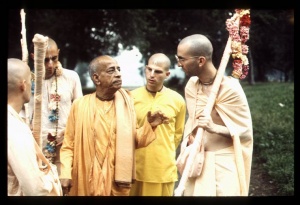CC Adi 13.30 (1975): Difference between revisions
(Vanibot #0027: CCMirror - Mirror CC's 1996 edition to form a basis for 1975) |
(Vanibot #0019: LinkReviser - Revise links, localize and redirect them to the de facto address) |
||
| Line 2: | Line 2: | ||
<div style="float:left">'''[[Sri Caitanya-caritamrta (1975)|Śrī Caitanya-caritāmṛta (1975)]] - [[CC Adi (1975)|Ādi-līlā]] - [[CC Adi 13 (1975)|Chapter 13: The Advent of Lord Śrī Caitanya Mahāprabhu]]'''</div> | <div style="float:left">'''[[Sri Caitanya-caritamrta (1975)|Śrī Caitanya-caritāmṛta (1975)]] - [[CC Adi (1975)|Ādi-līlā]] - [[CC Adi 13 (1975)|Chapter 13: The Advent of Lord Śrī Caitanya Mahāprabhu]]'''</div> | ||
<div style="float:right">[[File:Go-previous.png|link=CC Adi 13.29 (1975)|Ādi-līlā 13.29]] '''[[CC Adi 13.29 (1975)|Ādi-līlā 13.29]] - [[CC Adi 13.31 (1975)|Ādi-līlā 13.31]]''' [[File:Go-next.png|link=CC Adi 13.31 (1975)|Ādi-līlā 13.31]]</div> | <div style="float:right">[[File:Go-previous.png|link=CC Adi 13.29 (1975)|Ādi-līlā 13.29]] '''[[CC Adi 13.29 (1975)|Ādi-līlā 13.29]] - [[CC Adi 13.31 (1975)|Ādi-līlā 13.31]]''' [[File:Go-next.png|link=CC Adi 13.31 (1975)|Ādi-līlā 13.31]]</div> | ||
{{CompareVersions|CC|Adi 13.30|CC 1975|CC 1996}} | |||
{{RandomImage}} | {{RandomImage}} | ||
==== TEXT 30 ==== | ==== TEXT 30 ==== | ||
<div class="verse"> | <div class="verse"> | ||
:yāre dekhe, tāre kahe, | :yāre dekhe, tāre kahe,--kaha kṛṣṇa-nāma | ||
:kṛṣṇa-nāme bhāsāila navadvīpa-grāma | :kṛṣṇa-nāme bhāsāila navadvīpa-grāma | ||
</div> | </div> | ||
| Line 18: | Line 17: | ||
<div class="synonyms"> | <div class="synonyms"> | ||
yāre—whomever; dekhe—He sees; tāre—to him; kahe—He says; kaha—speak; kṛṣṇa-nāma—the holy name of Lord Kṛṣṇa; kṛṣṇa-nāme—by the holy name of Lord Kṛṣṇa; bhāsāila—was inundated; | yāre—whomever; dekhe—He sees; tāre—to him; kahe—He says; kaha—speak; kṛṣṇa-nāma—the holy name of Lord Kṛṣṇa; kṛṣṇa-nāme—by the holy name of Lord Kṛṣṇa; bhāsāila—was inundated; navadvīpa—the place of the name Navadvīpa; grāma—village. | ||
</div> | </div> | ||
| Line 32: | Line 31: | ||
<div class="purport"> | <div class="purport"> | ||
The present Navadvīpa-dhāma is but a part of the whole of Navadvīpa. Navadvīpa means | The present Navadvīpa-dhāma is but a part of the whole of Navadvīpa. Navadvīpa means "nine islands." These nine islands, which occupy an area of land estimated at thirty-two square miles, are surrounded by different branches of the Ganges. In all nine of those islands of the Navadvīpa area there are different places for cultivating devotional service. It is stated in the Śrīmad-Bhāgavatam ([[SB 7.5.23-24|7.5.23]]) that there are nava-vidha bhakti, nine different activities of devotional service: | ||
:śravaṇaṁ kīrtanaṁ viṣṇoḥ smaraṇaṁ pāda-sevanam | :śravaṇaṁ kīrtanaṁ viṣṇoḥ | ||
:arcanaṁ vandanaṁ dāsyaṁ sakhyam ātma-nivedanam | :smaraṇaṁ pāda-sevanam | ||
:arcanaṁ vandanaṁ dāsyaṁ | |||
:sakhyam ātma-nivedanam | |||
There are different islands in the Navadvīpa area for cultivation of these nine varieties of devotional service. They are as follows: (1) Antardvīpa, (2) Sīmantadvīpa, (3) Godrumadvīpa, (4) Madhyadvīpa, (5) Koladvīpa, (6) Ṛtudvīpa, (7) Jahnudvīpa, (8) Modadruma-dvīpa and (9) Rudradvīpa. According to the settlement map, our ISKCON Navadvīpa center is situated on the Rudradvīpa island. Below Rudradvīpa, in Antardvīpa, is Māyāpur. There Śrī Jagannātha Miśra, the father of Caitanya Mahāprabhu, used to reside. In all these different islands, Lord Caitanya Mahāprabhu, as a young man, used to lead His saṅkīrtana party. He thus inundated the entire area with the waves of love of Kṛṣṇa. | There are different islands in the Navadvīpa area for cultivation of these nine varieties of devotional service. They are as follows: (1) Antardvīpa, (2) Sīmantadvīpa, (3) Godrumadvīpa, (4) Madhyadvīpa, (5) Koladvīpa, (6) Ṛtudvīpa, (7) Jahnudvīpa, (8) Modadruma-dvīpa and (9) Rudradvīpa. According to the settlement map, our ISKCON Navadvīpa center is situated on the Rudradvīpa island. Below Rudradvīpa, in Antardvīpa, is Māyāpur. There Śrī Jagannātha Miśra, the father of Caitanya Mahāprabhu, used to reside. In all these different islands, Lord Caitanya Mahāprabhu, as a young man, used to lead His saṅkīrtana party. He thus inundated the entire area with the waves of love of Kṛṣṇa. | ||
Latest revision as of 14:14, 18 September 2020

A.C. Bhaktivedanta Swami Prabhupada
TEXT 30
- yāre dekhe, tāre kahe,--kaha kṛṣṇa-nāma
- kṛṣṇa-nāme bhāsāila navadvīpa-grāma
SYNONYMS
yāre—whomever; dekhe—He sees; tāre—to him; kahe—He says; kaha—speak; kṛṣṇa-nāma—the holy name of Lord Kṛṣṇa; kṛṣṇa-nāme—by the holy name of Lord Kṛṣṇa; bhāsāila—was inundated; navadvīpa—the place of the name Navadvīpa; grāma—village.
TRANSLATION
When Lord Caitanya Mahāprabhu was a student, He asked whomever He met to chant the Hare Kṛṣṇa mahā-mantra. In this way He inundated the whole town of Navadvīpa with the chanting of Hare Kṛṣṇa.
PURPORT
The present Navadvīpa-dhāma is but a part of the whole of Navadvīpa. Navadvīpa means "nine islands." These nine islands, which occupy an area of land estimated at thirty-two square miles, are surrounded by different branches of the Ganges. In all nine of those islands of the Navadvīpa area there are different places for cultivating devotional service. It is stated in the Śrīmad-Bhāgavatam (7.5.23) that there are nava-vidha bhakti, nine different activities of devotional service:
- śravaṇaṁ kīrtanaṁ viṣṇoḥ
- smaraṇaṁ pāda-sevanam
- arcanaṁ vandanaṁ dāsyaṁ
- sakhyam ātma-nivedanam
There are different islands in the Navadvīpa area for cultivation of these nine varieties of devotional service. They are as follows: (1) Antardvīpa, (2) Sīmantadvīpa, (3) Godrumadvīpa, (4) Madhyadvīpa, (5) Koladvīpa, (6) Ṛtudvīpa, (7) Jahnudvīpa, (8) Modadruma-dvīpa and (9) Rudradvīpa. According to the settlement map, our ISKCON Navadvīpa center is situated on the Rudradvīpa island. Below Rudradvīpa, in Antardvīpa, is Māyāpur. There Śrī Jagannātha Miśra, the father of Caitanya Mahāprabhu, used to reside. In all these different islands, Lord Caitanya Mahāprabhu, as a young man, used to lead His saṅkīrtana party. He thus inundated the entire area with the waves of love of Kṛṣṇa.